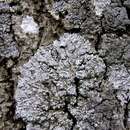en
names in breadcrumbs


Upper Surface: K+ yellow (atranorin), paraplectenchymatous, often pruinose, occ. maculate, occ. ciliate
Lower Surface: corticate, generally white, either paraplectenchymatous or prosoplectenchymatous, unbranched short rhizines
Algae: green (trebouxioid)
Reproduction: either apothecia or soredia, rarely both, never isidia
Spores: physcioid (thick-walled, not Physconia-type)
Worldwide.
Common name: Rosette Lichens
Family: Physciaceae
Relatively small or narrow-lobed foliose lichens, typically light gray (“atranorin gray”) and dull.
Found on all types of substrates, though typically associated with nutrient enrichment, such as dusty regions, near feedlots, under bird perches, etc. Often found with Xanthoria spp.
Heterodermia: usually lacks lower cortex, upper cortex prosoplectenchymatous
Phaeophyscia and Physciella: upper cortex K-, generally darker, never pruinose
Physconia: rhizines squarrose or at least mostly branched, generally dark below
Parmeliaceae: shiny at least near growing tips, typically much larger, spores totally different
Indicator of eutrophic habitats. Often relatively pollution-tolerant.
Physcia is a genus of lichenized fungi in the family Physciaceae.[4] The genus name means "inflated" or "sausage-like", referring to the form of the type species.[5] According to a 2008 estimate, the widespread genus contains 73 species.[6]
Physcia millegrana (apothecia)
Physcia millegrana (a foliose lichen), with an unlichenized polypore fungus (bottom right), on a fallen log
Physcia is a genus of lichenized fungi in the family Physciaceae. The genus name means "inflated" or "sausage-like", referring to the form of the type species. According to a 2008 estimate, the widespread genus contains 73 species.